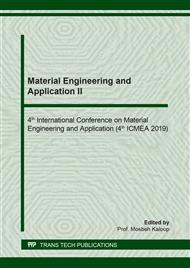[1]
Ö. Tunç, H. Tanaci, Z. Aksu, Potential use of cotton plant wastes for the removal of Remazol Black B reactive dye, J. Hazard. Mater. 163(1) (2009) 187-198.
DOI: 10.1016/j.jhazmat.2008.06.078
Google Scholar
[2]
L. Mouni, et al. Removal of Methylene Blue from aqueous solutions by adsorption on Kaolin: Kinetic and equilibrium studies, Appl. Clay Sci. 153 (2018) 38-45.
DOI: 10.1016/j.clay.2017.11.034
Google Scholar
[3]
L. Liu, Z. Y. Gao, X. P. Su, X. Chen, L. Jiang, J. M. Yao, Adsorption removal of dyes from single and binary solutions using a cellulose-based bioadsorbent, ACS Sustain. Chem. Eng. 3(3) (2015) 432-442.
DOI: 10.1021/sc500848m
Google Scholar
[4]
C. R. Holkar, A. J. Jadhav, D. V. Pinjari, N. M. Mahamuni, A. B. Pandit, A critical review on textile wastewater treatments: Possible approaches, J. Environ. Manage. 182 (2016) 351-366.
DOI: 10.1016/j.jenvman.2016.07.090
Google Scholar
[5]
M. Rafatullah, O. Sulaiman, R. Hashim, A. Ahmad, Adsorption of methylene blue on low-cost adsorbents: A review, J. Hazard. Mater. 177(1-3) (2010) 70-80.
DOI: 10.1016/j.jhazmat.2009.12.047
Google Scholar
[6]
D. Pathania, S. Sharma, P. Singh, Removal of methylene blue by adsorption onto activated carbon developed from Ficus carica bast, Arab. J. Chem. 10 (2017) S1445-S1451.
DOI: 10.1016/j.arabjc.2013.04.021
Google Scholar
[7]
Y. Koba, A. Ishizaki, Chemical composition of palm fiber and its feasibility as cellulosic raw material· for sugar production, Agric. Biol. Chem. 54(5) (1990) 1183-1187.
DOI: 10.1080/00021369.1990.10870116
Google Scholar
[8]
G. Pari, I. Sailah, Pembuatan Arang Aktif Dari Sabut Kelapa Sawit Dengan Bahan Pengaktif NH4HCO3 Dan (NH4)2CO3 Dosis Rendah 1, J. Penelitian Hasil Hutan. 19(4) (2001) 231-244.
DOI: 10.20886/jphh.2006.24.2.117-132
Google Scholar
[9]
D. S. Tong, et al. Adsorption of methylene blue from aqueous solution onto porous cellulose-derived carbon/montmorillonite nanocomposites, Appl. Clay Sci. 161 (2018) 256-264.
DOI: 10.1016/j.clay.2018.02.017
Google Scholar
[10]
A. S. Manna, D. Roy, P. Saha, Rapid methylene blue adsorption using modified lignocellulosic materials, Process Saf. Environ. Prot. 107 (2017) 346-356.
DOI: 10.1016/j.psep.2017.03.008
Google Scholar
[11]
M.T. Sundari, A. Ramesh, Isolation and characterization of cellulose nanofibers from the aquatic weed water hyacinth - Eichhornia crassipes, Carbohydr. Polym. 87(12) (2012) 1701-1705.
DOI: 10.1016/j.carbpol.2011.09.076
Google Scholar
[12]
L. Ni'mah, A. Ardiyanto, M. Zainuddin, Pembuatan Bioetanol Dari Limbah Serat Kelapa Sawit Melalui Proses Pretreatment , Hidrolisis Asam Dan Fermentasi Menggunakan Ragi Tempe, Info Tek. 16(2) (2015) 227-242.
DOI: 10.46559/tegi.v11i1.5214
Google Scholar
[13]
Gatot Siswo Hutomo, D. W. Marseno, S. Anggrahini, Supriyanto, Cellulose Extraction from Cacao Pod Husk Using Sodium Hydroxide, Agritech. 32(3) (2012) 223-229.
Google Scholar
[14]
M. Fan, D. Dai, B. Huang, Fourier Transform Infrared Spectroscopy for Natural Fibres, Fourier Transform - Mater. Anal. (2012).
DOI: 10.5772/35482
Google Scholar
[15]
J. Łojewska, P. Miśkowiec, T. Łojewski, L. M. Proniewicz, Cellulose oxidative and hydrolytic degradation: In situ FTIR approach, Polym. Degrad. Stab. 88(3) (2005) 512-520.
DOI: 10.1016/j.polymdegradstab.2004.12.012
Google Scholar


